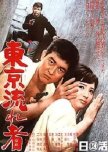This review may contain spoilers
"I'm a drifter, the man from Tokyo"
If you want a good example of a highly stylized film, Tokyo Drifter fits the bill. With its vibrant Crayon coloring, stagey architecture, and jazzy theme song sung and whistled by various characters throughout the film, it's more of a hypnotic experience than yakuza story.
When Tetsu and his boss Kurata attempt to go straight, the Otsuka gang works to bring them down by ruining a real estate deal Kurata is orchestrating. Three murders later, Tetsu is forced to go on the run or drift until the heat is off. Otsuka's hitman "The Viper" is always close on his tail. Tetsu evades him across Japan with the help of "Shootin' Star," another drifter who warns him that Kurata may betray him. One character observes, "It's hard to handle a man like that once he gets good and mad." Director Suzuki rewarded the audience with Tetsu finally becoming the hurricane he was renowned for being. The film ends predictably in Tokyo for predictable reasons, but the trip there made the ride worthwhile.
Suzuki edited the film in such a way that there were times I wasn't sure what happened. He could make it challenging to keep up, especially in the snowy battles in northern Japan or during a dreamlike fight on a snowy train track. You never knew what to expect, there was even a bar room brawl, of course in a Western bar because no one brawls like Brits and Americans. Though the film supplied plenty of fist fights, gun fights, even sword fights, none of the fights were particularly convincing. The final scene was orchestrated like models doing a shoot, color coordinated with the set's architectural pieces. The gun fight more a dance than a struggle for survival.
Aside from the use of vibrant colors, the lighting could be surreal and contrary to the rules of nature. The sets may have been stylish but also appeared flimsy, especially when someone bumped into a wall causing it to shake. There were gorgeous travelogue shots of Japan as Tetsu drifted through them. But it always came back to the bright neon lights of the seedy side of Tokyo. The film felt quintessentially 1960's in manic mood and color.
While the film could bounce around-the betrayals, alliances, and creative storytelling never let the momentum slow down. Tokyo Drifter is a surreal yakuza experience, but one that is worthwhile if you like arthouse films or those films a little on the vividly strange side.
8/8/23
When Tetsu and his boss Kurata attempt to go straight, the Otsuka gang works to bring them down by ruining a real estate deal Kurata is orchestrating. Three murders later, Tetsu is forced to go on the run or drift until the heat is off. Otsuka's hitman "The Viper" is always close on his tail. Tetsu evades him across Japan with the help of "Shootin' Star," another drifter who warns him that Kurata may betray him. One character observes, "It's hard to handle a man like that once he gets good and mad." Director Suzuki rewarded the audience with Tetsu finally becoming the hurricane he was renowned for being. The film ends predictably in Tokyo for predictable reasons, but the trip there made the ride worthwhile.
Suzuki edited the film in such a way that there were times I wasn't sure what happened. He could make it challenging to keep up, especially in the snowy battles in northern Japan or during a dreamlike fight on a snowy train track. You never knew what to expect, there was even a bar room brawl, of course in a Western bar because no one brawls like Brits and Americans. Though the film supplied plenty of fist fights, gun fights, even sword fights, none of the fights were particularly convincing. The final scene was orchestrated like models doing a shoot, color coordinated with the set's architectural pieces. The gun fight more a dance than a struggle for survival.
Aside from the use of vibrant colors, the lighting could be surreal and contrary to the rules of nature. The sets may have been stylish but also appeared flimsy, especially when someone bumped into a wall causing it to shake. There were gorgeous travelogue shots of Japan as Tetsu drifted through them. But it always came back to the bright neon lights of the seedy side of Tokyo. The film felt quintessentially 1960's in manic mood and color.
While the film could bounce around-the betrayals, alliances, and creative storytelling never let the momentum slow down. Tokyo Drifter is a surreal yakuza experience, but one that is worthwhile if you like arthouse films or those films a little on the vividly strange side.
8/8/23
Was this review helpful to you?

 54
54 188
188 11
11























